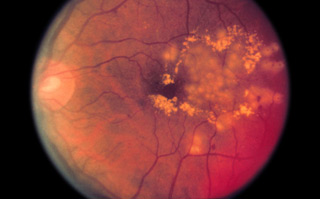Diabetic Retinopathy

What is Diabetic Retinopathy?
The damage to retinal vessels is referred to as diabetic retinopathy. There are two types of diabetic retinopathy: non-proliferative diabetic retinopathy (NPDR) and proliferative diabetic retinopathy (PDR). NPDR, commonly known as background retinopathy, is an early stage of diabetic retinopathy. In this stage, tiny blood vessels within the retina leak blood or fluid. The leaking fluid causes the retina to swell or to form deposits called exudates. Many people with diabetes have mild NPDR, which usually does not affect their vision. When vision is affected, it is the result of macular edema and/or macular ischemia. Macular edema is swelling or thickening of the macula, a small area in the center of the retina that allows us to see fine details clearly. Macular ischemia occurs when small blood vessels (capillaries) close. Vision blurs because the macula no longer receives sufficient blood supply to work properly.
Are there any symptoms?
Yes, symptoms include:
- Blurred or distorted vision or difficulty reading
- Floaters in your vision
- Partial or total loss of vision or a shadow or veil across your field of vision
How often should I be examined for Diabetic Retinopathy?
A medical eye exam is the best way to detect changes in your eyesight. An ophthalmologist can often diagnose and treat serious retinopathy before you are aware of any vision problems. People with diabetes should schedule examinations at least once a year.
Is there a cure and treatment?
The best treatment is to prevent the development of retinopathy. Strict control of your blood sugar will significantly reduce the long-term risk of vision loss from diabetic retinopathy. Treatment options include retinal laser and intravitreal injections of medicines designed to shrink the swelling of the macula.

